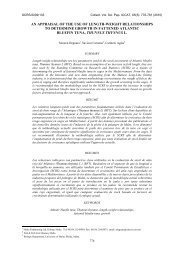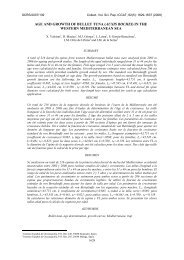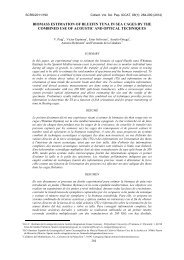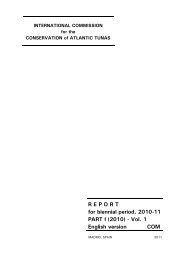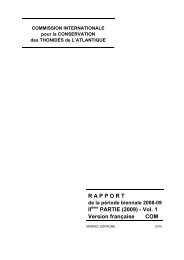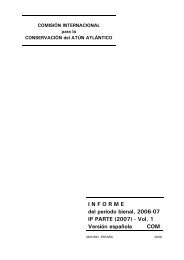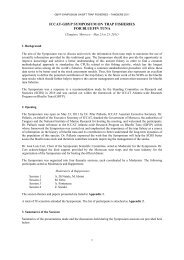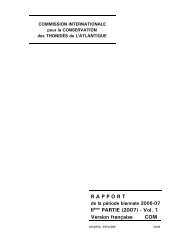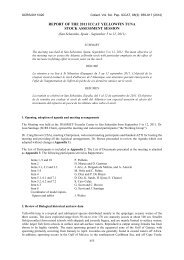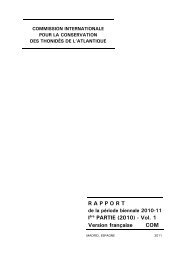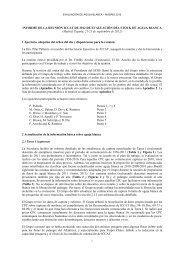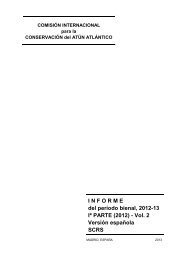E - Iccat
E - Iccat
E - Iccat
Create successful ePaper yourself
Turn your PDF publications into a flip-book with our unique Google optimized e-Paper software.
ICCAT REPORT 2002-2003 (II)<br />
– The relative importance of trade restrictive measures with respect to other tools for combating illegal fishing.<br />
Participants noted that, consistent with FAO's International Plan of Action to Prevent, Deter and Eliminate<br />
Illegal, Unreported and Unregulated Fishing, trade restrictive measures should be used in a manner that<br />
recognizes the rights of states to trade fish and fish products. Several participants advocated the notion that, for<br />
CPCs, trade restrictive measures should be used as a last resort after other tools (e.g., reductions in quota<br />
allocations) have proved to be unsuccessful (see paragraph 6.bis). There was significant debate as to the<br />
appropriateness of including this idea, which some viewed as a substantive policy issue rather than one of<br />
procedure. It was suggested that such a notion simply defined more clearly the notion of “effective measures” as<br />
set out in paragraph 5 of the UU Catches Resolution. At least one party noted that this concept was of such<br />
importance that it would have to be incorporated, if not into the current document, into ICCAT´s trade regime in<br />
some way - otherwise the present document would not be acceptable.<br />
– Specificity. Several participants stated their view that trade restrictive measures should not be limited to<br />
particular fisheries such as large-scale tuna longline vessels (LSTLVs) targeting a particular species (see<br />
paragraph A). However, the ICCAT practice to-date has been to develop specific instruments to deal with<br />
specific conservation issues; as cases of illegal fishing by large-scale longline vessels and illegal fishing of<br />
bluefin tuna and swordfish have been well documented, the existing Action Plans were developed to fight these<br />
cases.<br />
– Treatment of Parties. Some delegations expressed the view that different criteria should be applied when<br />
evaluating the fishing activities of CPCs and NCPs. Others felt it was more appropriate to have one set of criteria<br />
for the purposes of the current exercise. The two alternatives for paragraph B.2 reflect these differing views.<br />
– The process of Identification. Several participants stated their view that the Identification process in the UU<br />
Catches Resolution could be confusing. In this respect, the draft document refers to specific paragraphs in the<br />
UU Catches Resolution (e.g., paragraphs B.3 and B.4 refer to paragraph 2 in the UU Catches Resolution).<br />
However, one delegation questioned whether the text should refer to a different paragraph (paragraph 4 of the<br />
UU Catches Resolution, instead of paragraph 2).<br />
– Recurring illegal fishing activities. Several participants stated that once trade restrictive measures are lifted for<br />
a given party, then the entire process would need to be re-initiated from the beginning in case of a repeat offense.<br />
In other words, to be consistent with international law, the lifting of sanctions should be unconditional. Other<br />
participants argued that if the type of repeat illegal fishing activities was the same, then the process should be<br />
initiated at the stage of Identification pursuant to paragraph 2 of the UU Catches Resolution (see paragraph 9).<br />
They highlighted the difficulty in obtaining data and assessing flag state control when a country is under<br />
sanction and the lengthy time needed to recommend sanctions if the process returns to the beginning.<br />
– The behavior of vessels and the behavior of States. Some delegations argued that the criteria being discussed<br />
under paragraph B.2 referred to the behavior of vessels, and that it would be more appropriate to develop criteria<br />
to reproach States for not controlling their vessels. Other participants noted that existing instruments use criteria<br />
at the vessel level to help evaluate the how a flag state is carrying out its duties and therefore this draft proposal<br />
should aim to clarify those vessel-level criteria.<br />
– Scope of proposal. Several participants expressed concern that the intent of paragraph C was not clear. The<br />
Chair explained that the intent of the paragraph was not to supplant the BFT and SWO Action Plans, but rather<br />
to ensure that when these Action Plans are being implemented, the provisions under paragraph B of the current<br />
proposal be taken into account. It was noted that gaps in the coverage provided by the various Action Plans<br />
existed because not all fisheries and all species were contemplated (the SWO and BFT Action Plans cover these<br />
two species for all gears, and the UU Catches Resolution covers all species for LSTLVs only). The delegate of<br />
Japan stated that if the UU Catches Resolution were amended to cover other types of large-scale vessels, then<br />
paragraphs A and C would not be necessary.<br />
– Binding nature of the instruments. The Working Group noted that non-binding Resolutions have provided a<br />
foundation upon which binding trade action has been taken. Some parties stated their preference for developing<br />
binding Recommendations for this purpose. Several participants stated that the CPCs issues in paragraph 6.bis<br />
would be best addressed through a Recommendation such as the compliance instruments for bluefin tuna and<br />
swordfish [Ref. 96-14 and Ref. 97-08], appropriately amended.<br />
110



